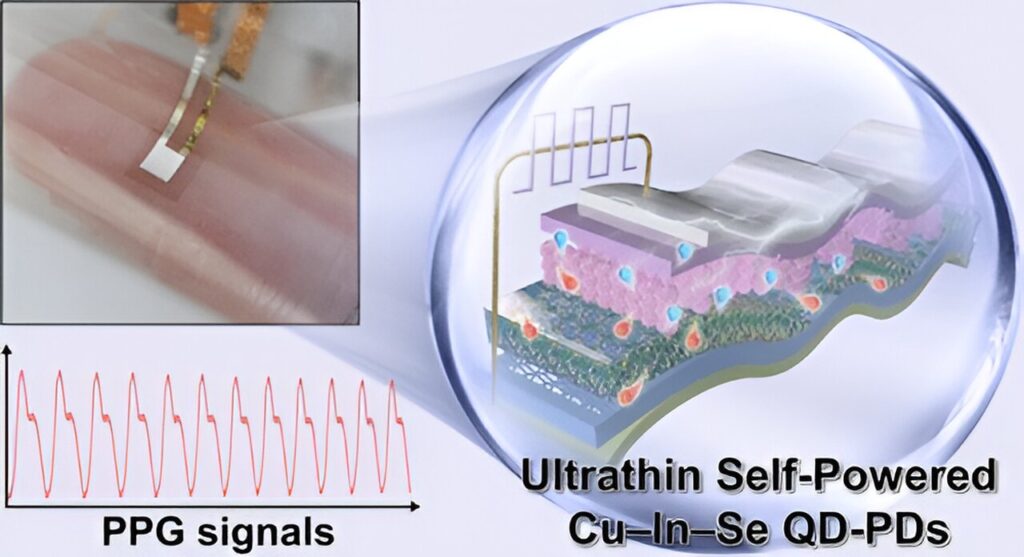credit: ACS nano (2023). DOI: 10.1021/acsnano.3c05178
Professor Yang Ji-eun of the Department of Energy Science and Engineering at the Gyeongbuk Institute of Science and Technology in Daegu has successfully developed the world’s highest-performance, environmentally friendly quantum dot optical sensor that does not require an external power source.
It has been confirmed that an environmentally friendly quantum dot optical sensor developed through joint research between Professor Choi Mun-ki’s research team and Professor Kim Dae-hyun’s research team from the Department of New Materials Engineering at the Ulsan Institute of Science and Technology (UNIST) has been put into practical use. The research team from Seoul National University’s Department of Chemical and Biomolecular Engineering (President Ryu Hong-rim) is able to stably measure optical signals without an external power source using the photovoltaic effect.
The joint research team also created a skin-worn ultra-thin pulse sensor based on this optical sensor and introduced a wearable pulse sensor that can stably acquire pulse signals even under different deformations.The work is published in diary ACS nano.
In recent years, due to the aging of the population and the coronavirus pandemic, demand has increased for healthcare monitoring devices that can be worn on the body for long periods of time to acquire biological signals. However, traditional silicon-based optical sensors are not widely used in practice because they are heavy and stiff, making them uncomfortable to wear for long periods of time. Also, because it cannot adhere to the skin, it is not possible to accurately acquire biological signals.
This year’s Nobel Prize in Chemistry was awarded to three scientists who discovered and developed quantum dots, also known as the seeds of nanoscience. Quantum dots are ultrafine semiconductor particles, just a few nanometers (nm, one billionth of a meter) in size, that can transport electrons and holes with superior optical and electrical properties than traditional semiconductor materials. Can be separated quickly.
Quantum dots have the advantage of fast response speed when used as optical sensors, so research into optical sensors using quantum dots is being widely conducted. However, most existing quantum dot optical sensors are thicker than a few micrometers, and most of the research uses quantum dots such as lead sulfide (PbS), which contains toxic heavy metals. Therefore, in practice, this dot cannot be used for wearable light sensors.
The research team has now succeeded in developing an ultra-high performance quantum dot optical sensor based on copper indium selenide (Cu-In-Se) quantum dots, which are environmentally friendly and do not contain heavy metals. It was generally accepted that optical sensors based on environmentally friendly quantum dots had poor performance. Nevertheless, the research team improved the electrical properties of environmentally friendly quantum dots by controlling the size and composition of the dots, and developed a new organic-inorganic hybrid charge transfer layer suitable for the dots, making them environmentally friendly. I created a quantum dot. A dot light sensor that outperforms existing toxic quantum dot light sensors.
The environmentally friendly quantum dot optical sensor developed by the research team shows high device performance even with a quantum dot absorption layer of about 40 nanometers (nm). Furthermore, it exhibits excellent light detection performance without an external power supply. These two properties can be of great advantage for the applications and usage of wearable optical sensors.
The research team also developed a wearable pulse sensor that combines an optical sensor and light source fabricated on a polymer-based flexible substrate. The sensor has the flexibility to operate stably even with a radius of curvature of 0.5 millimeters (mm), and after being attached to the human body, it can stably measure pulses even in various situations where there is movement such as walking or running. It’s done. .
Professor Yang said, “By controlling the structure of environmentally friendly quantum dots and developing a charge transfer layer optimized for the dots, we were able to create a high-performance and environmentally friendly quantum dot optical sensor. ” he said.
Professor Moon Kee Choi of UNIST said, “We were able to create a highly flexible, ultra-thin pulse sensor based on an environmentally friendly quantum dot optical sensor that does not require an external power source. “It has the potential to be used for sensor applications.” , lidar, infrared cameras, and wearable healthcare monitoring systems. ”
For more information:
Shi Li et al. Ultrathin self-powered heavy metal-free Cu-In-Se quantum dot photodetector for wearable health monitoring; ACS nano (2023). DOI: 10.1021/acsnano.3c05178
Provided by: Daegu Gyeongbuk Institute of Science and Technology (DGIST)
Quote: High-performance quantum dot photosensor requires no external power source (December 11, 2023) From https://phys.org/news/2023-12-high-performance-quantum-dot-photosensor-external.html Retrieved December 11, 2023
This document is subject to copyright. No part may be reproduced without written permission, except in fair dealing for personal study or research purposes. Content is provided for informational purposes only.

